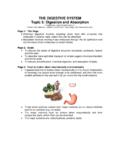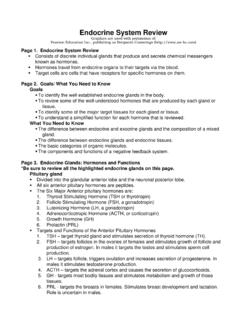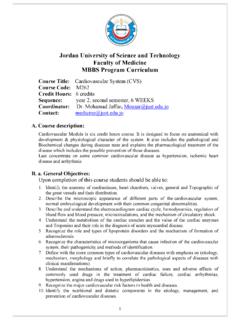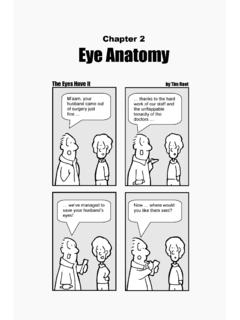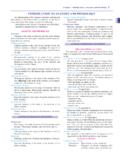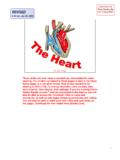Transcription of Anatomy Review: Urinary System - …
1 Interactive PhysiologyAnatomy review : Urinary SystemGraphics are used with permission ( )Benjamin Cummings Publishing Co ( )Page 1. Introduction The Urinary System rids the body of waste materials and controls the volume and composition o fbody fluids. Highly specialized cells in the kidneys are essential to these 2. Goals To review the Anatomy of the Urinary System , particularly the kidney To examine the vascular and tubular portions of the nephron To compare and contrast the specialized cells of the tubular epithelium To review the unique structure of the juxtaglomerular apparatusPage 3. The Urinary System The Urinary System is composed of paired kidneys and ureters, the Urinary bladder, and the urethra.
2 Urine is produced in the kidneys, and then drains through the ureters to the Urinary bladder, wherethe urine is stored. Urine is eliminated from the body through the urethra. Label this diagram:Page 4. External Structure of the Kidneys Each bean-shaped kidney is embedded in a fatty adipose capsule. The kidneys are retroperitoneal, lying against the dorsal body wall in the upper Physiology2 An adrenal gland, which is part of the endocrine System , lies on top of each kidney. Several structures enter or exit the concave surface of the kidney at the renal hilus, including theureter and the renal vein, which drains into the inferior vena cava. Label this diagram:Page 5. blood Supply of the Kidneys When the renal vein is removed and the kidney is shown in frontal section, you can see the deeperrenal artery and its connection to the abdominal aorta.
3 Branching from the renal artery are the segmental and lobar arteries. Together, these vessels provide the kidneys with a rich blood supply under high pressure that allowsthem to continuously filter and cleanse the blood . Label this diagram:Page 6. Internal Structure of the Kidney Internally, the human kidney is composed of three distinct regions:1. Renal Cortex The outermost layer is called the renal cortex. It contains about one million nephrons, thefiltering units that form urine. Types of Nephrons: Cortical nephrons - lie completely within the cortexInteractive Physiology3 Juxtamedullary nephrons - lie in both the cortex and medulla2. Renal Medulla The middle layer is called the renal medulla, in which you can see the triangular renalpyramids.
4 These pyramids look striated because of parallel bundles of ducts carrying urinefrom the nephrons. The areas between pyramids are the renal columns. They are extensions of the cortex thatprovide a route for the passage of blood vessels and nerves to and from the outer Renal Pelvis The funnel-shaped renal pelvis is within the renal sinus. The renal pelvis collects urine fromthe pyramids and conveys it into the ureter for passage to the Urinary bladder. Label this diagram:Page 7. Nephron Overview The nephron is the structural and functional unit of the kidneys. It consists of a specialized tubularstructure and closely associated blood 8. Nephron Structure: Associated blood Vessels blood entering the kidney through the renal artery flows first into the segmental arteries and theninto the lobar arteries.
5 From there, it enters the interlobar arteries, the arcuate arteries, the small interlobular arteries, andthe still smaller afferent arterioles, which empty into a capillary bed called the glomerulus. Leading away from the glomerulus is the efferent arteriole. Notice that the afferent arteriole is largerin diameter than the efferent arteriole. blood passes from the efferent arteriole into the peritubular capillaries and vasa recta. From there, blood drains into the interlobular vein, flows into the arcuate vein and enters theinterlobar vein, eventually reaching the renal vein. Label this diagram:Interactive Physiology4 Page 9. Nephron Structure: Tubular Segments Label this diagram: The expanded cup-shaped end of the tubule surrounding the glomerulus is called the glomerular, orBowman s, Physiology5 Water and solutes pass from the blood into the glomerular capsule, and then flow into the proximalconvoluted tubule, or PCT.
6 After many loops and convolutions, the tubule straightens out, and fluid flows down the descending,or thin, segment of the loop of Henle into the medullary region, and then up the ascending, orthick, segment back into the cortical region. From the loop of Henle, the fluid then enters the twists and turns of the early and late distalconvoluted tubule, or DCT, eventually emptying into a cortical collecting duct. This duct extends into the medulla, forming the medullary collecting duct, which carries the urinethrough the tubules of the renal pyramids to the renal pelvis.** Now is a good time to go to quiz questions 1-4: Click the Quiz button on the left side of the screen.
7 Work through questions 1-4. After answering question 4, click the Back to Topic button on the left side of the screen To get back to where you left off, click on the scrolling page list at the top of the screen and choose " Features of the Renal Corpuscle".Page 10. Cellular Features of the Renal Corpuscle The glomerulus, with its larger incoming afferent arteriole and smaller outgoing efferent arteriole,is nested within the glomerular capsule something like a fist thrust into a balloon. Together, thesestructures are called the renal corpuscle. The visceral layer of the glomerular capsule is made up of specialized cells called podocytes, whichsurround the permeable capillaries.
8 Between the visceral and parietal layers of the capsule lies the capsular space, which collects the fluidand solutes being filtered from the blood . Label this diagram: In longitudinal section, the endothelial lining shows small openings called fenestrations, whichallow for the passage of water and solutes such as ions and small molecules. There are fenestrations between endothelial cells in the capillary. The porous basement membrane encloses the capillary endothelium. Surrounding the basement membrane is a layer of podocytes. These cells have large leg-like extensions, which in turn have small fringe-like extensions called pedicels. Pedicels from adjacent areas interdigitate loosely to form spaces called filtration Physiology6 Substances being filtered must pass first through the fenestrations, then through the basementmembrane, and finally through the filtration slits and into the capsular space.
9 Together, the capillary endothelium, basement membrane, and podocytes make up the filtrationmembrane. Label this diagram: Extending from the podocyte cell body are leg-like extensions containing the fringe-like extensions and pedicels wrap around the capillary and interdigitate to form the filtrationslits. Label the diagram on the top of the next page:Interactive Physiology7 Page 11. Structure of the Filtration Membrane in Cross Section A cross section of the filtration membrane reveals a large podocyte with its nucleus and pedicels. Thewhite areas are portions of the capsular space. Gaps between the pedicels are the filtration slits. The basement membrane of the capillary endothelium separates the podocyte from the capillarywith its fenestrations.
10 Label this diagram: Notice that the filtration membrane permits the escape of small molecules, while preventing largemolecules from leaving the bloodstream and passing through into the capsular Physiology8 Page 12. Cells of the Proximal Convoluted Tubule (PCT) Label this diagram: The simple cuboidal cells of the proximal convoluted tubule are called brush border cells because o ftheir numerous microvilli, which project into the lumen of the tubule. These microvilli greatly expand the surface area of the luminal membrane, adapting it well for theprocess of reabsorption. Tight junctions between adjacent cells permit passage of water but limit the escape of large moleculesfrom the tubular lumen into the interstitial space.


